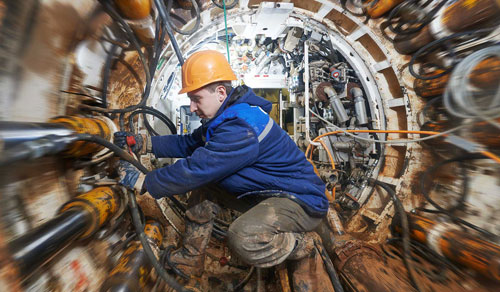
People working in confined spaces face life-threatening hazards including toxic substances, electrocutions, explosions, and asphyxiation. Image courtesy of atec.edu.au.
The Occupational Safety and Health Administration has issued a final rule to increase protections for construction workers in confined spaces, which could prevent hundreds of serious injuries every year.
Confined spaces can be loosely defined as manholes, crawl spaces, tanks, and other places that are not intended for continuous occupancy. Confined spaces are also, because of their calculated design for other purposes, difficult to exit in an emergency. People working in confined spaces, without taking proper precautions, can face life-threatening hazards such as toxic substances, electrocutions, explosions, and asphyxiation.
OSHA states this new rule – which was 25 years in the making and spans 161 pages – will significantly improve the safety of construction workers who enter confined spaces, estimating that it will reduce the number of injuries and fatalities by 96 percent, thus preventing about 780 serious injuries every year.
The OSHA final rule adds a new subpart to 29 CFR Part 1926 to provide protections to employees working in confined spaces in construction. The new subpart replaces OSHA’s one training requirement for confined space work with a “comprehensive standard that includes a permit program designed to protect employees from exposure to many hazards associated with work in confined spaces, including atmospheric and physical hazards.”
According to OSHA, the final rule is similar in content and organization to the general industry confined spaces standard, but it also incorporates several provisions from the proposed rule to address construction-specific hazards, to account for advancements in technology, and to improve the enforceability of the requirements.
There are now new obligations on the various employers who may have their employees involved with construction site confined spaces. One important requirement added to the rules relates to the responsibilities of the host employer (the owner of the site containing the confined space), the controlling contractor (who has primary control over the construction project), and the entry employer (whose employees will enter the confined space).
The regulation makes the controlling contractor, rather than the host employer, the primary point of contact for information about the permit confined spaces at the worksite. The host employer must provide information it has to the controlling contractor who in turn passes the information to the entry employer. In addition, the controlling contractor is responsible for making sure that employers outside of the confined space do not create hazards in the confined space, and that multiple entry employers working in a confined space at the same time do not create hazards for each other’s employees.
The new rule becomes effective on August 3, 2015.
With such a complex and immense rule, employers are encouraged now to review their construction confined space policies, procedures, and training programs to ensure compliance with the new standard.
Filed Under: Construction, News, O&M, Policy, Training





Hello, I just read article about:
“OSHA releases final confined space rule”
I hawe a question, do employers need permision to work in confined spaces?
For example in wind turbine blades?
Thank you,
Intars